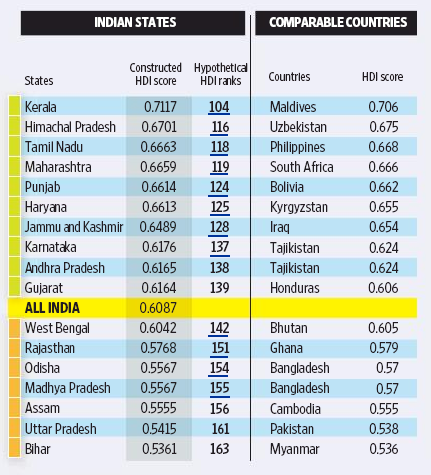The United Nations Development Programme (UNDP) is the United Nations’ global development network.
Headquartered in New York City, UNDP advocates for change and connects countries to knowledge, experience and resources to help people build a better life. One of its initiatives is a period publication of ranking of countries based on the ‘Human Development Index’ or ‘HDI’. This Index was devised jointly by Nobel Laureate Amartya Sen and Mahbub Ul Haq and is an attempt to examine the quality of life of the people living in a particular country.

Since its inception, the report has tended to rank India in the low 130’s, below neighbours like Pakistan and Sri Lanka, and even a few war-torn African countries.
For a country with a consistent track record of high economic growth (even during the so-called slump of 2010-14, India’s nominal GDP growth was over 6%) this would seem to be surprising.
To understand why this situation persists, let us first understand the components that go into the HDI.
The Index is calculated using three inputs:
- Life Expectancy at birth
- Years of schooling
- Standard of living (Per capita income)
India’s life expectancy has been in the region of 66 years since about 2010, showing neither significant increase of decrease. This places India at a rank of about 140 in terms of overall life expectancy – a long way away from Japan, Spain and Switzerland (life expectancy 83), but also well behind countries like Colombia, Iran, Syria and many others that you would normally not associate with being ahead of India in anything.
On the front of per capita income, India does slightly better thanks to the increase in the size of the GDP since liberalisation. At US$ 5,808 we rank about 125th in the list of countries, well behind Qatar and Singapore. But to make a fair comparison, India should be compared with countries with similarly large populations. Unfortunately, we also lag far behind the US (above US$ 50,000) and the United Kingdom (almost US$ 40,000). Even developing, large-population countries like China (US$ 13,000) and Indonesia (US$ 10,000) have a much higher per-capita than India does.

It is evident then, that India’s relatively low life expectancy and per-capita GDP make it difficult for India to do well on an index like this, but the most damning of all is the third indicator. In terms of number of years of schooling, India’s performance is perhaps worst of all. At slightly over four years of schooling for the average child, it is this parameter that sinks India’s HDI ranking the most.
It is also pertinent to note that too much of our national conversation and Governmental focus is on only one of the three parameters – the National Income. Yes, talk of development and reforms all aim at boosting the growth rate of the economy, and whether you believe in the ‘trickle-down effect’ of economic growth or not, it is obvious that the expansion of GDP will have a mathematical impact on the HDI.
However, the budgetary allocation for Health services has only seen a marginal increase over the last year (less than 10%, from Rs 30,645 crores to Rs 33,150 crores). Even after the increase, the proportion of Healthcare expenditure to the overall budget is a mere 4.5%. For comparison, India spends as much as 17% of its GDP on Defence expenditure (not on internal law-and-order which, some might argue, is more critical).
On the education front the allocation remains below the 6% of GDP that is considered the desirable level for a country. It might be argued that for India, which is so low on educational indicators, the allocation should be even higher.
But therein lies the story of India’s dismal show on the HDI indicators – a policy that focuses almost exclusively on the finances of the country without giving enough attention to the health and minds of its people. For India to make true progress towards becoming a developed country or a superpower, it needs to step up the allocation of resources to Health services and Education, especially primary education, and ensure implementation of the policies like Right to Education and post-natal healthcare.
Until this happens, ‘Development’, perhaps, without the ‘Human’ interest, will keep India low on this ‘Index’.
































Very good theoary.